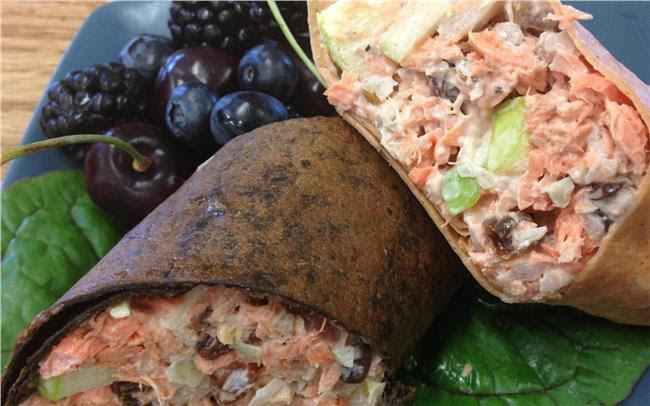 Excerpted from WildforSalmon.com
Excerpted from WildforSalmon.com
Wild Salmon products are high in brain supplementing Omega 3’s which can actually facilitate new brain cell formation and improve memory. Few single foods can bring as many health contributions to your diet in significant quantities as wild Alaskan salmon. Wild salmon is an excellent source of Omega-3 fatty acids which are necessary for optimum maternal and infant health. We have featured a quick and easy salmon recipe to get your Omega-3’s on the go or while at school!
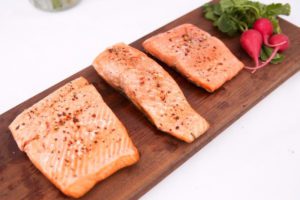 Main benefits from wild salmon:
Main benefits from wild salmon:
- Omega 3 fatty acids
- High Quality Protein
- Essential Amino Acids
- Vitamin A
- Vitamin D
- Vitamin B6
- Vitamin B
- Vitamin E
- Appreciable amounts of calcium, iron, zinc, magnesium, and phosphorus
All these benefits combine to make wild Alaskan sockeye salmon the natural choice for anyone concerned with their own or their family’s health.
Nutrition Facts: Omega 3’s
What are they?
Omega-3 fatty acids are a group of polyunsaturated fatty acids that are important for a number of functions in the body.
Where are they?
Omega-3 fatty acids are not produced naturally by the human body, therefore they must be consumed in ones diet by eating fish, nuts, seeds, and certain green leafy plants.
What do they do?
Omega-3 fatty acids are important to early childhood brain development. Omega-3’s have also been linked to reducing chances of stroke, depression, and mental decline with aging.
Omega-3 Fatty Acids:
- Protect heart health
- Reduce risk of sudden death from heart disease
- Reduce risk of stroke
- Reduce chance of heart disease in Type 2 Diabetes
- Essential in infant brain and eye development during pregnancy and infancy
- Improve blood lipid patterns
- Improve blood vessel function
- Improve symptoms of immune and inflammatory disorders such as rheumatoid arthritis, Crohn’s disease and some skin conditions
- Reduce the risk of some mental disorders such as Alzheimer’s disease and depression
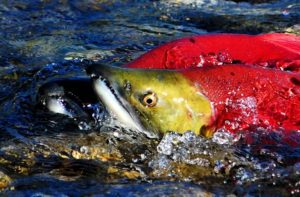 The protective role of fish against heart disease and cancer may be attributed to the type of oil found in certain species of coldwater fish, especially Alaska salmon. These fish oils, referred to as “Omega-3”, are polyunsaturated. Their chemical structure and metabolic function are quite different from the polyunsaturated oils found in vegetable oils, known as “Omega-6”.
The protective role of fish against heart disease and cancer may be attributed to the type of oil found in certain species of coldwater fish, especially Alaska salmon. These fish oils, referred to as “Omega-3”, are polyunsaturated. Their chemical structure and metabolic function are quite different from the polyunsaturated oils found in vegetable oils, known as “Omega-6”.
The type of dietary fat (monounsaturated, saturated, or polyunsaturated) we consume alters the production of a group of biological compounds known as eicosanoids (prostaglandins, thromboxanes, and leukotrienes). These eicosanoids have biological influences on blood pressure, blood clotting, inflammation, immune function, and coronary spasms. In the case of Omega-3 oils, a series of eicosanoids are produced, which may result in a decreased risk of heart disease, inflammatory processes, and certain cancers.
Omega-3 oils also exert additional protective effects against coronary heart disease by:
- decreasing blood lipids (cholesterol, low-density lipoproteins or LDL, and triglycerides)
- decreasing blood clotting factors in the vascular system
- increasing relaxation in larger arteries and other blood vessels
- decreasing inflammatory processes in blood vessels
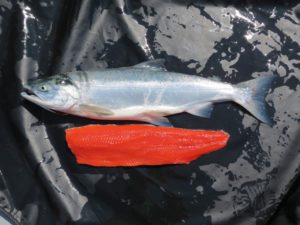 Additional studies have provided exciting news about the benefits of Omega-3 oils for individuals with arthritis, psoriasis, ulcerative colitis, lupus erythematosus, asthma, and certain cancers. Research studies have consistently shown that Omega-3 fatty acids delay tumor appearance, and decrease the growth, size, and number of tumors.
Additional studies have provided exciting news about the benefits of Omega-3 oils for individuals with arthritis, psoriasis, ulcerative colitis, lupus erythematosus, asthma, and certain cancers. Research studies have consistently shown that Omega-3 fatty acids delay tumor appearance, and decrease the growth, size, and number of tumors.
A recent study at the University of Washington has confirmed that eating a modest amount of salmon (one salmon meal per week) can reduce the risk of primary cardiac arrest. Cardiac arrest claims the lives of 250,000 Americans each year. Fresh, fresh-frozen, or canned Alaska sockeye salmon provides the highest amount of Omega-3 fatty acids of any fish — 2.7 grams per 100 gram portion. Other studies, such as the Zupthen Study, a 20-year investigation of a Dutch population, confirmed similar benefits. The risk of coronary heart disease decreased (as much as 2.5 times) with increasing fish consumption. This suggests that moderate amounts (one to two servings per week) of fish are of value in the prevention of coronary heart disease, when compared with no fish intake.
Why Wild?
We do know that fish is important for our health. However, this is a complex issue. Logically we’d think farm-raised would be better for our environment and better for us. (By the way, “ocean-raised” fish is the same as “farm-raised” just a new marketing name. Farm-raised fish are fish in pens in the ocean and when this got a bad reputation they changed the name, that’s all!) But we have learned that farm raised means that the fish don’t get lots of swimming room, are prone to disease (and therefore fed antibiotics) and can get out and infect the fish in the wild. They are also high in mercury. Many wild-caught fish start in Alaska, but recently we are finding a trend to save money– where the is fish shipped to China or Russia for processing, resulting in the fish being thawed and refrozen multiple times! Read the label closely, to avoid products that are moved around the world, to save companies’ money! Our salmon and whitefish are always wild-caught in Alaska in accordance with sustainable harvest practices, and is always once frozen after processing in Alaska.
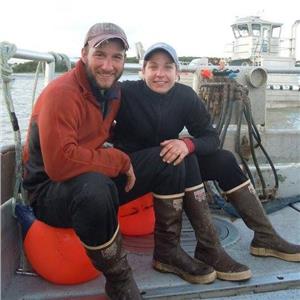 “Where does this come from?” is the most important question you can ask yourself about anything you are consuming.
“Where does this come from?” is the most important question you can ask yourself about anything you are consuming.
Let’s look at Farmed Salmon. Since Farmed Salmon are fed pellets instead of what they eat in the wild, three elements are affected:
- First, the food that they normally eat in the wild converts into powerful omega 3’s for us; the farm raised salmon doesn’t have as high nutritional value.
- Secondly, the food they eat naturally helps them turn that beautiful pink color to which we are accustomed; the farm raised are therefore fed colorings to make them more palatable to our eye.
- Finally, the food they eat affects how they taste and there is truly no comparison in flavor or texture.
When choosing to eat fish, we must consider:
- The importance of fish to our health with valuable Omega-3s, protein, low fat.
- The sustainability of the fish, that it is not over-fished and that it is safe for our environment.
- The health of the fish and the life of the fish (what it eats, how it lives).
- Cost. We really can’t afford to eat farmed salmon.
- Taste!
Fish, particularly cold water oily fish, have valuable Omega 3’s. We should strive for two to three servings (total of 6 – 12 ounces per week — as one serving is considered 3- 6 ounces) per week of a fish high in Omega 3’s.
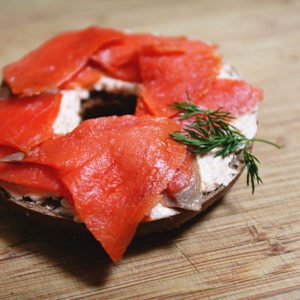 We know that wild Salmon has great benefits; however, most grocery stores and restaurants that offer “salmon” are offering a genetically engineered (farmed) salmon that is taking over the environment. Or, we find out, that because of the way the fish is caught, its habitats are being damaged and it’s becoming endangered. We have to carefully look at where the fish is caught and whether or not the fishery is sustainable. It is important that we make sure our fish is sustainable and safe for the environment.
We know that wild Salmon has great benefits; however, most grocery stores and restaurants that offer “salmon” are offering a genetically engineered (farmed) salmon that is taking over the environment. Or, we find out, that because of the way the fish is caught, its habitats are being damaged and it’s becoming endangered. We have to carefully look at where the fish is caught and whether or not the fishery is sustainable. It is important that we make sure our fish is sustainable and safe for the environment.
It is also important that we make sure the fish is healthy and therefore truly healthful. Farm-raised fish are raised in small pens in the ocean secured by nets or in ponds, depending upon the fish species. As with most industries, maximizing revenues is key so they will stock a pond with as many fish as they can leaving very little room for the fish to move about freely and they are fed pellets of food instead of their natural food (sounds like the chicken and cattle scenarios all over again). This, in turn, doesn’t allow them to use their muscles naturally nor convert their natural food into powerful Omega 3s for us. Therefore, farm-raised fish doesn’t have the health benefits of Wild fish and farm-raised salmon doesn’t have the color of natural salmon and they are fed colorings to help make the salmon palatable for our plates.
Jenn K’s Salmon Salad Recipe
From Wild for Salmon
A favorite on the Ava Jane, Wild for Salmon’s fishing boat, during the busy fishing season! Try this scrumptious seafood salad on a tortilla wrap with lettuce, chips, toasted bread with a slice of melted cheese or dipped into with crackers.
Ingredients:
- 2lb wild-caught sockeye salmon
- 1 medium onion, chopped fine
- 1 cup mayonnaise
- 1 medium tart apple, chopped into small pieces
- 1/2 cup raisins or dried cranberries
- 1/2 cup of course chopped nuts (walnut or pecan)
Instructions:
- Season salmon to taste with olive oil, pepper and salt. Broil skin side down for 8 minutes. Remove from oven and let cool.
- While salmon is cooling- mix other ingredients together. Once salmon is cooled, flake salmon into a large mixing bowl and mix with the remaining ingredients.
- Serve and enjoy!

